Yehliu (野柳) is a 1,700 meters long cape on the north coast of Taiwan, between Taipei and Keelung in Wanli Township. The cape, known by geologists as the Yehliu Promontory, forms part of the Taliao Miocene Formation. It stretches approximately 1,700 meters into the ocean and was formed as geological forces pushed Datun Mountain (大屯山) out of the sea.
Yehliu is a small fishing town northeast of Taipei, Taiwan known for its geological rock formations carved out by sea erosions. Thousands of tourists flock here every year to see the famous Queen's Head, along with Fairy Shoes, Ginger Rocks, Sea Candles and other cleverly-named rock formations.
In the north of Taiwan close to the second largest harbour in Keelung is one of the world's greatest natural wonders. Due to its bizarre rock formations, Yehliu Park provides visitors with scenery that could be from a distant planet. But the polymorphic shapes of the rock are not extraterrestrial but the result of an ancient process that dates back several million years, erosion.
Some of the rocks seem to grow out of the ground like giant mushrooms. The reason for this lies in the composition of the rock strata. The more elevated sections are often far harder and weatherproof than the lower layers that crumble away and have been transformed into gravel and sand.
In 1964 the Yehliu Peninsula was officially designated as a park and since then it has been one of Taiwan's most important and popular tourist attractions. The park consists of a total area of around fifty three hectares of land and more than four hundred hectares of coast.
Its rocky terrain flanks the South China Sea.
It is famous for the curious rock formation, carved by sea erosion. A number of rock formations have been given imaginative names based on their shapes. The most well-known is the "The Queen's Head" (女王頭), an iconic image in Taiwan and an unofficial emblem for the town of Wanli. Other formations include "The Fairy Shoe", "The Bee Hive", "The Ginger Rocks" and "The Sea Candles."
Taiwan Yeh Liu/Yeliou [Jilong] is "One of Top Ten Most Beautiful Coast in China"Ranked by China National Geography Magazine.
Apart from the scenery, Yeliou Scenic Area also features the Ocean World, which is the first ocean park in Taiwan to have live sea creature performances. At Ocean World, you are able to see performances of dolphins and sea lions. The Ocean World also features a 100 meter long undersea tunnel for you to watch all sorts of marine life at your own leisure.
After you have finished observing the special coastal geology, if you have the time and the inclination you can indulge yourself in some water activities. You might consider taking a relaxing holiday at Greenbay, a natural beach with eye-catching scenery that has been designated as a coastal resort. The center of recreation in this area is between Yeliu and Wanli, where there are all sorts of recreational facilities and a 1.5-kilometer beach where you can swim, surf, or engage in other water sports. The steep mountain slopes just next to the seashore make this a popular place for hang-gliding and parasailing as well.
If you want to visit Yeh Liu, a tour can be a good idea. You can follow a two days tour of Yeliu with a travel route such as :
Day1 : Yeliu -> Yeliu Ocean World -> Green Bay
Day2 : Eighteen Wang Gong Temple -> Fugui Cape
Photos of YehLiu Geologic Landscapes :

The Queens Head (女王頭)

Twin rocks
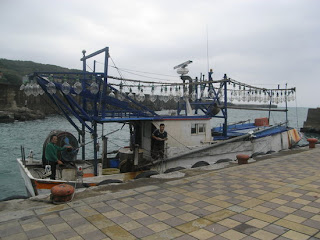
Fishing boat in Yeliu harbour
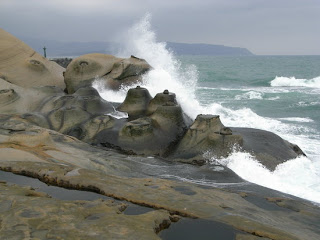
Big waves and strange rocks

the ocean near yehliu.

Martian Landscape at Yeliu. All the bizarre landscape and lava formations.

Yehliu is a 1,700 meters long cape on the north coast of Taiwan, between Taipei and Keelung in Wanli Township

Ocean World is located along the beautiful North Coast near Yeliu, a scenic area with abundant natural resources.
Watch Yehliu Geopark Natural Wonders at Taipei Taiwan 野柳地質公園 video
Jumat, 20 November 2009
Yeliu Taiwan Rock Formations Coast
Diposting oleh
Airlines Stewardess
di
08.05
0
komentar
![]()
Label: Yeliu
Rabu, 04 November 2009
Hsinchu Taiwan Nightlife Hotspots Guide
Hsinchu (新竹 or Xin Zhu) is a city in the north-western part of Taiwan. Hsinchu is the oldest city in northern Taiwan.
Hsinchu is an old city, with a history more than 400 years. Due to the constant gusts of wind that blow in from the Taiwan Strait, Hsinchu is often referred to as the Windy City.
Hsinchu is famous for its two remarkable university such as National Chiao Tung University Hsinchu, and National Tsing Hua University Hsinchu.
How to get Hsinchu :
By plane :
The nearest airport is Taoyuan International Airport, which is about a thirty minute drive in the dead of night with no traffic and a speeding taxi driver. Safest to allow around an hour from Science Park or a little longer from down-town.
By bus :
From Taipei
The How-Tai Bus Company (豪泰客運) run a fast, cheap (NT$110), efficient and very comfortable (extra wide seats with personal video screens) service from Taipei to Hsinchu. In Taipei, the red buses depart every fifteen minutes from bay 22 at the Taipei Bus Terminal - also called Taipei Intercity Bus Terminal (See: Taipei 'Get in'). From Hsinchu, the buses depart from next to the Hsinchu Railway Station (when exiting the station, the bus stop is a two minute walk to the left, just past the Hsinchu Bus Station), and makes a stop at the National Tsing Hua University bus station en-route to the freeway. NB: If your ticket is not collected before departure, hang on to it. It will need to be given to the driver when getting off. The journey takes between 1 hour 20 minutes to 1 hour 30 minutes.
From Taoyuan Taiwan Airport :
There are no direct buses from Taoyuan Taiwan Airport (Taipei International Airport) to Hsinchu, but the U-bus company offers a link, with passengers changing buses at the 'Jhongli Transit Station'.
From Taichung :
Taichung Bus (台中客運) and Guoguang Bus (國光客運) connect Hsinchu to Taichung.
By train :
The TRA (or regular train) station is in the city centre and is a major stop on the main line between Taipei and Kaohsiung/Taichung. It costs from NT$114 to NT$180 for an adult and takes approximately one to two hours to get there from Taipei main station, depending upon the type of train you take.
The Taiwan High Speed Rail (THSR) has a Hsinchu stop located in the neighbouring city of [Chubei] (竹北; zhúbĕi) and is approximately 30 minutes by taxi from the city centre. The journey from Taipei takes approximately 30 minutes
Hsinchu Tourist attractions :
Visiting Hsinchu is not complete without visit its main attractions such as Eighteen Peaks Mountain, Glass Arts and Crafts Museum, Eastern Gate, Cheng Huang Temple. Temples are various in Hsinchu, and is the landmark of the city.
Hsinchu Nightlife
Hsinchu is not Taipei or Kaoshiung. We cannot compare their nightlife. But we can focus at Ming Zu Road, lane 33 (also known as Bar Street) for a good place to go and meet both local Taiwanese, Ex Pats, and travelers. Don't miss the Red Bar and TJ's, the Coach Pub and Pumpkin. Pumpkin has a kitchen and offers good tasting Thai food, they will also deliver to any of the other bars in the area.
Pig and Whistle is a pub-restaurant on the first floor and a dancing pub on the second. There's a stage with bands playing on the weekend. That's near the ambassador hotel, the highest building in Hsinchu.
Hsinchu Nightlife, Museum, and Temples Photos and Pictures :
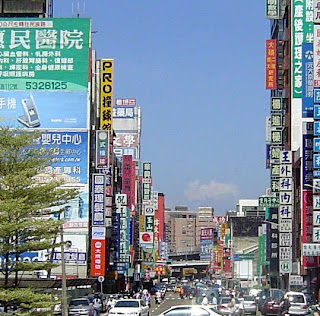
A street in downtown Hsinchu. Hsinchu has a population about 404,109

City God Temple. Located on the corner of Zhongshan Road and Dongmen Street, is a typical Taoist temple with lots of colorful frescoes.
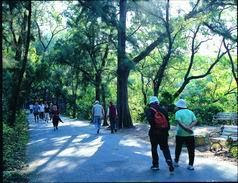
Eighteen Peaks is a brilliant getaway from the hustle and bustle of the city and an ideal place to stretch your legs. The park, composed of 18 hills and a number of walking trails, is at its best in March when the flowers are in bloom and is a very popular destination with locals and expats.

Cheng Huang Temple, or "City God" Temple of Hsinchu. It is regarded as the highest-ranking of all City God temples in Taiwan, due to the superior spiritual power of its City God in protecting the town. There is a night market in front of the temple, with a lot of small stalls selling Taiwanese snacks.
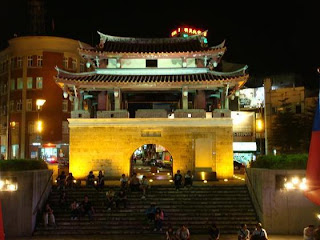
The most famous landmark in Hsinchu. Accordingly, Hsinchu residents refer to it as the "Mother of Hsinchu", protecting the city and its people. This East Gate is the only gate left from the initial 4, for 4 directions: "Yi Suang" in the West, "Ying Xi" in the East, "Gexum" in the South, and "Gongcheng" in the North. However, the Japanese destroyed 3 of them in 1902 while building a new road system.

Glass and Crafts Museum, a gallery dedicated to Hsinchu's long association with the craft of glass making. It is in the park directly behind the railway station.
Watch Hsinchu Science-Based Industrial Park
A day in the life of the Hsinchu Science-Based Industrial Park, often referred to as "Asia's Silicon Valley".
Home to over four hundred high-tech companies, the Science Park is the world's center of semiconductor research, design and manufacture. Other well-represented industries include telecommunications, biotechnology and optoelectronics. Every day, thousands of managers, engineers and factory workers stream into the Park to play their part in creating the world's IT infrastructure.
Diposting oleh
Airlines Stewardess
di
23.50
0
komentar
![]()
Label: Hsinchu
















.jpg)


.jpg)





